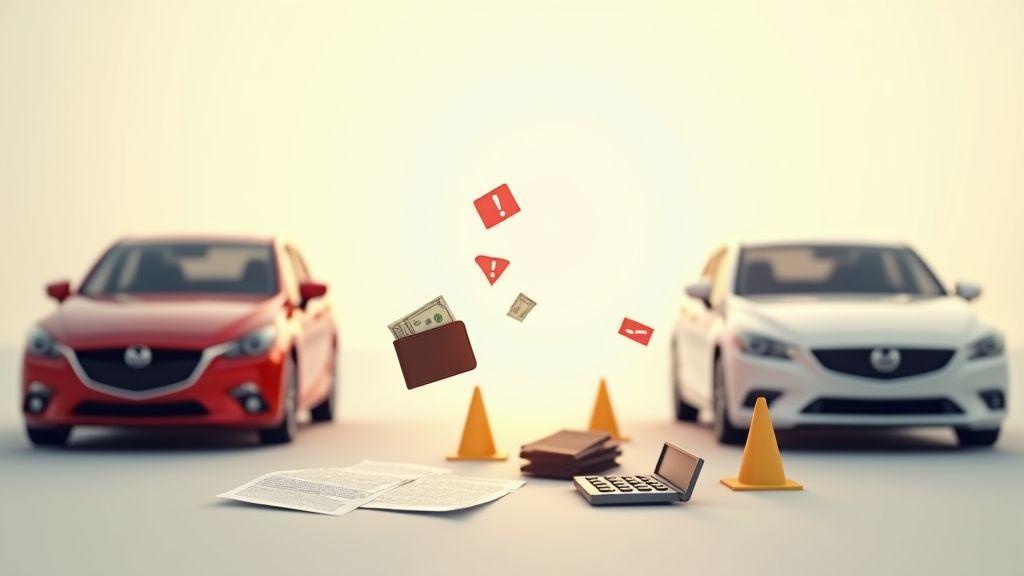Mistakes to Avoid When Financing a New or Used Car — this guide shows what to watch for so you keep control of the deal. You should check your credit score before you apply. Your score shapes the interest rate you get. Learn how to access and fix report errors and bring proof when you prequalify. Compare offers from banks, credit unions, and dealers and get written APR and term comparisons from several lenders. Know the difference between APR and simple interest and how very long loan terms can make you overpay; calculate total interest first. Avoid rolling negative equity into a new loan and don’t confuse trade-in value with a cash down payment. Watch for hidden fees and dealer add-ons and demand an itemized contract. For used cars, get a full vehicle history, a mechanical inspection, and proof of a clear title before you sign.
Key Takeaway
- You don’t check your credit score first
- You skip comparing loan offers
- You focus only on monthly payment, not total cost
- You don’t get pre-approved before you shop
- You ignore loan terms and hidden fees

Check your credit score before you apply
You should check your credit score well before you sign any loan papers. Lenders use that number to set the interest rate and to decide if they will lend to you. Knowing your score gives you time to fix problems or shop for a better deal.
Pull reports from each major bureau: Equifax, Experian, and TransUnion. You can request your free annual credit reports once a year. Look for mistakes, old accounts, and high balances that push up your credit utilization.
If you find issues, act fast: pay down high balances, stop opening new accounts, and correct errors. Even small moves can cut the APR you’re offered. Walk into the dealer knowing your score so you won’t be surprised by the loan terms.
How your credit score affects the interest rate you receive
Your credit score is the single biggest factor in the APR you’ll be offered. Higher scores usually mean lower rates. Lower rates mean smaller monthly payments and much less total interest over the life of the loan.
A small change in APR can add up. For example, a half-point higher rate on a five-year loan can cost you hundreds more. That’s why guarding your score before you apply is smart. Shop lenders after you check your score so you can compare offers with clear eyes.
| Credit Score Range | Typical APR (New Car) | Typical APR (Used Car) |
|---|---|---|
| 760–850 | 2%–4% | 3%–6% |
| 700–759 | 4%–6% | 6%–9% |
| 640–699 | 6%–10% | 9%–14% |
| 300–639 | 10% | 14% |
How to access and correct errors on your credit report
Get your free reports at AnnualCreditReport.gov or directly from the three bureaus. Review each report line by line for wrong names, addresses, accounts that aren’t yours, or incorrect balances. Identity theft and old collections are common culprits.
When you spot an error, file a dispute with the bureau and the creditor. Provide copies of supporting documents like payment receipts or a letter from the original lender. Keep records of every call and email. If a bureau fixes an error, ask for a corrected report you can show lenders.
- Get reports from all three bureaus and save copies.
- Mark every incorrect or unfamiliar item.
- Gather proof: receipts, bank statements, letters.
- File a dispute online or by mail with the bureau and the creditor.
- Follow up until the bureau sends a corrected report or closure letter.
- If unresolved, add a brief consumer statement to your report and keep documentation.
Bring proof of corrected errors when you prequalify
When you prequalify, bring the corrected report and any dispute confirmation letters or creditor statements. Lenders will move faster if you can show official documents. A printed correction can change an offer on the spot and stop a higher rate from sticking. Also review the site’s privacy policy to understand how personal information is handled before sharing sensitive documents with any third party.

Compare financing offers from banks, credit unions, and dealers
You should compare offers because the numbers you see at first glance can hide important details. A low APR might come with a short term and higher monthly payments. A dealer offer can include incentives that look good, but fees, add-ons, or conditional rebates can raise your total cost.
Banks, credit unions, and dealers each play by different rules. Banks often have quick online approvals and standard pricing. Credit unions usually give lower rates if you qualify because they’re member-owned. Dealers can offer manufacturer deals and trade-in flexibility but may stack interest or fees. Use an example: a dealer’s 0% offer could cost you if you lose a cash rebate or accept a longer term that raises overall interest paid.
Follow a clear checklist when you compare. The Consumer Financial Protection Bureau offers tools to compare auto loan offers and terms. Get the same car details and loan length from each lender so you compare apples to apples. Take these steps in order:
- Request a written APR and term from each lender for the exact vehicle and down payment.
- Ask for the full payoff amount, monthly payment, and any fees.
- Use the numbers to compare total cost over the loan life, not just the monthly payment.
| Lender type | Typical APR range | What to watch for |
|---|---|---|
| Bank | 3%–8% (varies by credit) | Fast service; watch fees and prepayment penalties |
| Credit Union | 2%–6% | Lower rates for members; may require joining |
| Dealer | 0%–9% | Promotional rates may drop out with rebates or add-ons |
Ranges are examples. Your rate depends on credit, down payment, and vehicle.
Why you should get quotes from at least three lenders
Getting quotes from three places gives you leverage. When you have multiple written offers, you can show them to a dealer or lender and ask for a better deal.
More quotes also expose hidden differences. One lender might quote a low APR but charge high origination fees. Another might offer a slightly higher rate but no fees and lower monthly payments. You’ll spot those trade-offs only if you compare at least three offers side by side.
How prequalification can show you likely rates without hard pulls
Prequalification uses a soft credit check so you can see likely rates without hurting your score. Many banks and credit unions give a quick estimate online after a soft pull.
Remember the estimate isn’t a final promise. Once you apply, a hard pull will confirm your rate. But prequalifying helps you narrow choices and avoid surprises later.
Ask each lender for a written APR and term comparison
Ask each lender to give you a written breakdown showing APR, loan term, monthly payment, total paid over the loan, and any fees. A short note or email with those numbers prevents confusion and gives you proof to compare or negotiate. If a lender hesitates, that’s a red flag — get the figures in writing before you decide.

Understand loan terms, APR, and long loan term mistakes on car financing
You need to read the loan sheet like a map. Look for the loan term, APR, interest type, and monthly payment. Dealers will point you to a low monthly payment. That feels good, but a low monthly number can hide a high total cost. Keep your eye on Total Interest and the full number of months.
Ask: does the rate quoted include fees? That’s what APR shows. Also check whether interest is simple interest — charged on the remaining balance — or another method. Many borrowers make the mistake of picking a longer term to lower monthly cost, then realize later they paid much more in interest. This is one of the common Mistakes to Avoid When Financing a New or Used Car.
Run the numbers before you sign. Compare a few scenarios: different down payments, different terms, and the same APR. A little math now keeps you out of a long, expensive surprise later.
The difference between APR and simple interest explained for you
APR stands for Annual Percentage Rate. It shows the yearly cost of the loan including some fees. APR gives you a better apples-to-apples view between offers.
Simple interest is interest charged only on the unpaid principal. Payments reduce the principal, and interest drops as you pay. APR and simple interest answer different questions: APR says what you pay overall each year; simple interest shows how monthly charges are calculated.
| Item | What it includes | How it affects you |
|---|---|---|
| APR | Interest some fees | Shows true yearly cost; use to compare loans |
| Simple interest | Interest on remaining principal | Lower cost if you pay off faster or make extra payments |
Why very long loan terms can make you overpay interest
Longer terms drop your Monthly Payment, and that feels like a win. But you pay interest for more months. That adds up. For example, a 72-month loan will charge interest for 6 years instead of 3. Even a few percentage points of interest become big dollars over time.
Long terms also raise the chance you’ll owe more than the car is worth (being upside down). If you total the car or want to trade it in, you could still owe the lender. A short term or a larger down payment cuts that risk and reduces Total Interest you pay.
Calculate total interest over the life of the loan before signing
Do a quick total-cost check: multiply the Monthly Payment by the number of months, then subtract the loan principal — the result is Total Interest. Use an online loan calculator if math isn’t your thing.
- Multiply monthly payment × number of months.
- Subtract the original loan principal.
- The result = Total Interest you will pay.

Avoid rolling negative equity and confusing trade-in value with down payment
You can save a lot by keeping negative equity off your next loan. If your current car’s loan balance is higher than its trade-in value, that gap is negative equity. Rolling that gap into a new loan means you start the new contract underwater, paying interest on a balance that came from your old car. That raises your monthly payment, lengthens the loan, and costs you more in interest over time.
Dealers often blur trade-in value and down payment to make a sale look cleaner. The trade-in is a way to reduce what you owe on the new car if the dealer pays you cash for your old vehicle. A true down payment comes from your pocket and lowers the financed amount cleanly. Confusing the two can hide how much of the new loan is actually for negative equity versus the vehicle you’re buying.
Act before you sign. Know the payoff on your current loan, get a firm trade-in appraisal, and calculate how much negative equity exists.
What negative equity is and why rolling it into a new loan hurts you
Negative equity happens when your loan balance is larger than your car’s resale or trade-in value. Imagine owing $15,000 while your car is worth $10,000 — that $5,000 shortfall is negative equity. If you roll that into a new loan, you finance that $5,000 on top of the price of your next car.
Financing negative equity looks fine on paper but costs you over the life of the loan. You pay interest on money that didn’t buy your new car. That raises monthly payments and can trap you in longer terms.
How trade-in value differs from a cash down payment in your deal
A trade-in value is what a dealer offers for your old car; it reduces the amount the dealer needs to finance on the new sale. A cash down payment is money you pay at signing that immediately lowers how much you borrow. The two lower your loan in different ways and have different effects on taxes and loan structure.
Relying on a trade-in can hide the real cost if you have negative equity. With a cash down payment, you cut the financed amount cleanly and avoid adding past debt into a new loan.
Get a separate payoff quote and trade-in appraisal before you negotiate
Before you walk into a dealership, get a written payoff quote from your lender and an independent trade-in appraisal. Then follow these steps:
- Call or log in to your lender and request the exact payoff amount and payoff date.
- Get at least one appraisal from a trusted online service or local dealer and compare it to the dealer’s offer.
- Bring both documents to negotiations so you can separate the value of the car from any leftover debt.
| Item | Why it matters | What to look for |
|---|---|---|
| Payoff quote | Shows exact amount you still owe | Date-stamped amount, fees included |
| Trade-in appraisal | Gives market value for your car | Comparable listings, condition notes |
| Difference between them | Reveals negative equity amount | If payoff > appraisal, that gap is negative equity |

Watch for hidden fees in car financing contracts and add-on traps
Hidden fees can turn a good deal sour fast. If you skip the fine print, you may pay for documentation fees, processing charges, or dealer prep costs that quietly raise your loan balance. One of the biggest Mistakes to Avoid When Financing a New or Used Car is ignoring these sneaky line items; they add to your loan principal and can balloon your monthly payment without you noticing. See the FTC guidance to avoid dealer fees and add-on traps.
Dealers and lenders sometimes bundle fees into the monthly payment instead of the sticker price. That makes the car seem cheaper up front, but you end up paying interest on fees over the life of the loan.
You have leverage. Ask for the full breakdown before you sign. If a line item looks vague — like administration or dealer fee — press for what it covers and whether it can be removed.
Common hidden fees in car financing contracts to look for
Some fees are obvious, others hide in plain sight. Watch for origination fees, dealer documentation fees, title and registration markups, and extended warranty roll-ins. Each can tack on hundreds — sometimes thousands — to the total cost and to the interest you pay across the loan term.
Ask direct questions about each charge. If the dealer wants to roll add-ons into the loan, you’ll pay interest on them. That’s why you should know the real out-the-door price before financing.
| Fee | What it is | Typical cost | How it affects you |
|---|---|---|---|
| Documentation fee | Dealer paperwork processing | $100–$400 | Raises out-the-door price; often financed |
| Loan origination fee | Lender charge to set up loan | $100–$500 | Added to loan principal; you pay interest |
| Title/registration markup | Dealer handles DMV items | $20–$200 | Small fee but sometimes inflated |
| Extended warranty | Optional protection plan | $500–$3,000 | Large, often financed, increases monthly payment |
| Dealer add-ons | Paint protection, window tint, etc. | $50–$2,000 | Usually optional; financing spreads cost over term |
- Ask for an itemized price before you sign. Read each line and refuse anything vague.
How dealer add-ons and extended warranties can raise your monthly payment
Dealers may pitch add-ons like fabric protection, rustproofing, or VIN etching at signing. Some are useful; many are not. If the dealer adds them and rolls them into the loan, you’ll pay interest on that extra cost every month. A $1,000 add-on can feel small today but may cost you several hundred dollars more over the life of the loan.
Extended warranties are sold like peace of mind, and sometimes they offer value. But if you finance the warranty, you again pay interest on it. Compare the warranty price to third-party options and read what’s covered. If you want protection, buy it separately or pay cash so you don’t inflate the loan.
Request an itemized contract that lists every fee in writing
Always ask for a fully itemized contract that spells out each fee in plain language. If a fee isn’t listed, it doesn’t belong in your loan. Get everything on paper and take your time to read it; a clear, written list is your best defense against surprise charges. Also take a moment to review the lender’s standard policies and a sample terms of use so you know what contract language commonly covers.

Avoid used car loan pitfalls with inspections and history checks
When you buy a used car, checks and inspections are your safety net. A history report can stop you from paying for someone else’s trouble. Think of that report as a flashlight in a dark garage — it shows hidden dents, past floods, and odometer rollbacks. Use official resources to check vehicle history and title status. Skip it and you pay later, often in surprise repairs or a dropped resale value.
Lenders watch the same signs. A salvage title or unpaid lien can kill your loan or raise your rate. If you hand over cash or sign papers before checking, you might learn the hard way.
Keep your eyes on the full picture: vehicle history, title status, and a mechanic’s report. These affect the loan amount, monthly payment, and whether the lender will finance the car at all. Remember the phrase Mistakes to Avoid When Financing a New or Used Car — skipping these steps is high on that list.
Why you must check vehicle history reports and title status
A vehicle history report tells you about crashes, flood damage, and past owners. It also records odometer readings and whether the car was ever branded as salvage.
Title status proves who really owns the car and if there are liens. An unpaid lien means the lender could repossess the car even after you buy it. Check the title through your state DMV and ask the seller for clear title documents. If the paperwork is messy, walk away. It’s also smart to search safety recalls by vehicle VIN before you buy.
How a pre-purchase mechanical inspection protects your financing choice
A pre-purchase inspection catches problems a history report won’t show. Mechanics probe brakes, suspension, engine health, and frame damage. They give you a written list of fixes and costs. That report gives you bargaining power or a reason to decline the sale.
Lenders like documented inspections. A clean report speeds up approval and may help you get better terms. If repairs are needed, the inspection lets you calculate true cost and avoid being stuck with a bad loan.
Require inspection and clear title proof before finalizing a used car loan
Always demand both a clean title and a signed inspection report before you sign loan papers. Do not accept verbal promises. Get documents in hand and verify them with the DMV or lender. If the seller refuses, treat that as a red flag and walk away.
- Request a full vehicle history report (VIN-based).
- Ask for the original title and check for liens.
- Arrange a pre-purchase inspection by an independent mechanic.
- Get the inspection in writing and share it with your lender.
- Verify VIN and title details with your DMV before final signatures.
| What to check | Why it matters |
|---|---|
| Title status / Liens | Lenders can refuse or repossess if liens exist |
| Vehicle history report | Reveals accidents, flood, odometer issues |
| Pre-purchase inspection | Shows hidden mechanical problems and repair costs |
Common Mistakes to Avoid When Financing a New or Used Car (quick checklist)
- Skipping the credit check and applying blind
- Not getting multiple written offers (at least three)
- Focusing only on monthly payment instead of total interest and APR
- Rolling negative equity into the new loan
- Letting dealer add-ons be financed without clear consent
- Signing without a clear title and inspection on used cars
Conclusion
You hold the keys to a smart car deal. Check your credit score early, get prequalified, and shop written offers from several lenders so you compare APR, term, and total interest — not just the tempting monthly payment.
Don’t let a low payment blindside you. Know the difference between APR and simple interest, run the numbers, and calculate total interest over the life of the loan. Shorter terms and larger down payments keep you out of costly surprises.
Keep old baggage out of new loans. Avoid rolling negative equity into your next car. Treat trade-in value and a cash down payment as separate tools, not the same thing.
Demand transparency. Insist on an itemized contract and push back on hidden fees and dealer add-ons. If something is vague, walk away — paperwork should help you, not be hustled past you.
For used cars, don’t skip the basics: get a full vehicle history, a written mechanical inspection, and proof of a clear title before you sign. A small upfront check is a big shield against future headaches.
You’ll do fine if you stay inquisitive, insist on written numbers, and keep your eyes on the full cost — not the sales pitch. Want more practical guides like this? Read more at Meridian Pioneer homepage, or if you need assistance, visit our contact page.

